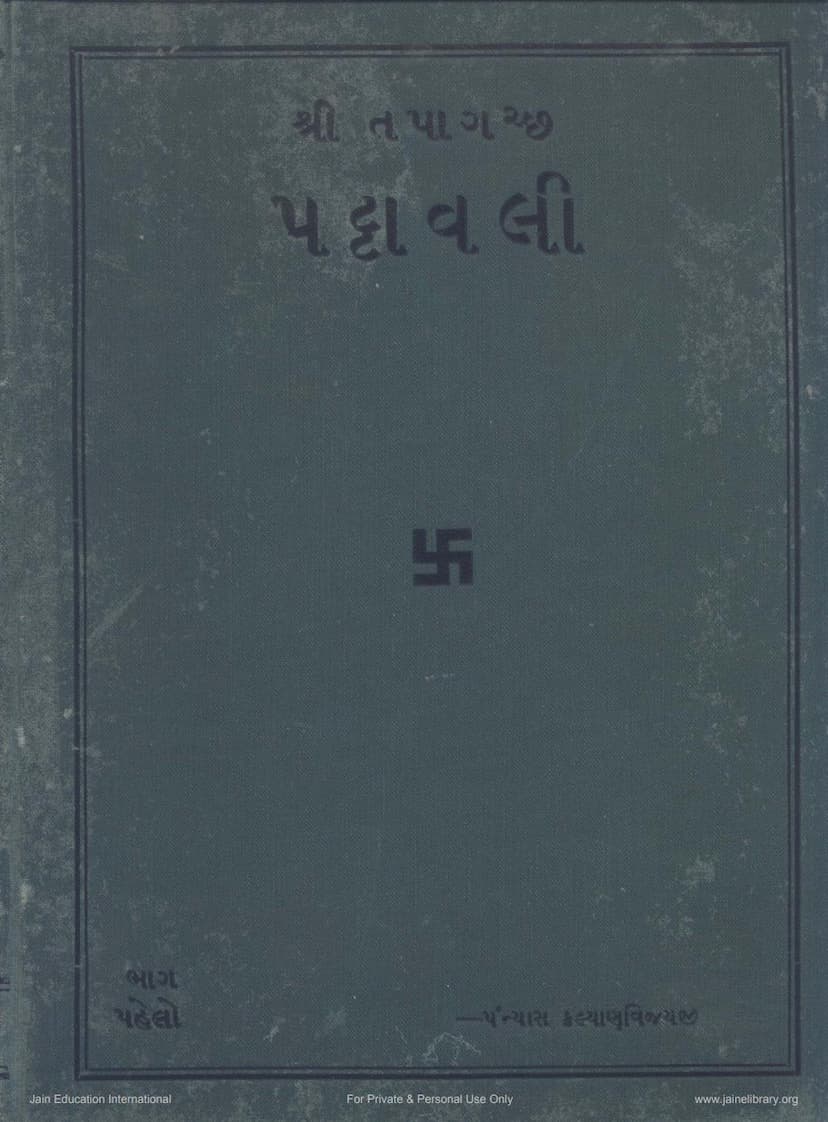Tapagaccha Pattavali
Added to library: September 2, 2025

Summary
This document is a portion of a Jain text titled "Tapagaccha Pattavali" (The Lineage of the Tapagaccha), compiled by Kalyanvijay Gani. The publisher is Shri Vijaynitisurishwarji Jain Library, Ahmedabad. The catalog link provided is https://jainqq.org/explore/005201/1. The text is marked as "JAIN EDUCATION INTERNATIONAL FOR PRIVATE AND PERSONAL USE ONLY".
The provided pages contain the initial sections of the book, including:
- Title Page: Clearly states the title, author, and publisher. It also includes a dedication and the foundational invocation "Namo thuhnam Shramanasya Bhagavato Mahavirasya" (Homage to the Ascetic, the Blessed Lord Mahavira).
- Table of Contents (Anukramanika): This is a detailed index listing numerous figures, mostly Jain acharyas and lineage heads (Pattadharas), along with the chapters/pages dedicated to them. It spans from the earliest disciples of Lord Mahavira (Shudharmaswami) through various influential figures and leaders of different Jain gacchs (sects/schools).
- Introduction/Preface (Prastavana): This section discusses the origins of various Jain gacchs from the lineage of Lord Mahavira's Ganadharas. It highlights the challenges in tracing lineage due to historical events like wars and foreign invasions, which led to the destruction of many ancient texts and records. It also touches upon the diversity of thought and the emergence of different schools (gachhas) within Jainism, drawing parallels with other religions. The text notes that Lord Mahavira had eleven Ganadharas, from whom nine gacchs originated. It specifically mentions the "Sudharma Gachha" and its prominent leaders.
- Historical Context of Jainism: The introduction touches upon the past glory of Jainism, its spread across various regions of India, and the decline in its numbers over centuries, attributing it to various factors including the rise of other religious movements and the assimilation of followers.
- Gachha Descriptions: A significant portion of the introductory part lists numerous Jain gacchs (estimated to be 84 in number according to tradition). It mentions the origins of some, like the Nirgrantha Gachha, Kautika Gachha, Vanavasi Gachha, and the eventual evolution of the Vadagachha into the Tapagachha. The text notes that the names and origins of all 84 gacchs are not clearly documented.
- Biographical Sketches of Acharyas: The bulk of the provided text appears to be a detailed listing and brief biographical account of the acharyas (spiritual leaders) of the Tapagachha and other prominent gacchs. It covers a vast historical period, mentioning figures who lived between the 5th and 9th centuries of Vikram Samvat and beyond. The text highlights their contributions, philosophical insights, and their role in spreading Jainism.
- Specific Mentions:
- Upaadhyay Shri Dharma Sagarji: His life and works are discussed, noting his intellectual prowess, his firm stance against incorrect doctrines, and his role in scholarly debates.
- Panyas Shri Kalyanvijayji: The editor and compiler, whose efforts are acknowledged for bringing this ancient manuscript to light.
- Shri Vijaynitisurishwarji Jain Library: The publisher.
- Shri Vardhamana Tirthankar: Mentioned as the root of the Guru tradition.
- Shri Sudharmaswami: Described as the first Pattadhar (lineage holder) and the fifth Ganadhara. His lifespan and significance are detailed.
- Shri Jambuswami: The second Pattadhar, described as leaving behind his worldly life and family for spiritual pursuit. His interaction with robbers and his role in the spread of Jain teachings are mentioned.
- Shri Prabhava Swami, Shri Shyayambhavaswami, Shri Yashobhadraswami, Shri Sambhutivijaya, Shri Bhadrabahuswami, Shri Sthulabhadra: These are sequential Pattadharas mentioned in the table of contents, indicating the historical flow of the Tapagachha lineage.
- Shri Hemchandracharya: Mentioned as a "Kalikal Sarvagnya" (Omniscient of the Kaliyuga), highlighting his significant contribution to Jain literature and his influence on rulers like Kumarpal.
- Shri Hiravijayasurishwarji: Referred to as "Jagadguru" (Guru of the Universe), his interaction with Emperor Akbar is noted, signifying his profound impact on spreading Jain principles even among non-Jains.
- Various Gachhas: The text lists and provides brief descriptions of numerous gacchs such as Nirgrantha, Kautika, Vanavasi, Upakesha, Vajrashakha, Nagil, Pandikashakha, Nivrutti Kula, Brahmadvipa, Harshapur, Maladhari, Sānder, Vadgachha, Karanta, Kuchapuriya, Chaityavasa, Nanaval, Chitravāla, Vidhipaksha, Tapagachha, Kharatara, Anchal, Sārdhapūrṇimiy, Āgamic, Bāhḍa, etc. The evolution of some gacchs, like the Vadagachha into the Tapagachha, is also noted.
The text emphasizes the importance of adhering to the teachings of the Tirthankaras and the rigorous practices of the Acharyas in maintaining the purity of the Jain tradition. The compiler, Kalyanvijay Gani, along with others, is credited with the meticulous work of bringing this manuscript to light. The preface also expresses hope that this historical compilation will serve as a beacon for future scholars.
The primary focus of this book is to chronicle the succession of spiritual leaders within the Tapagachha and other related Jain gacchs, providing a historical and genealogical account of Jain spiritual lineage.